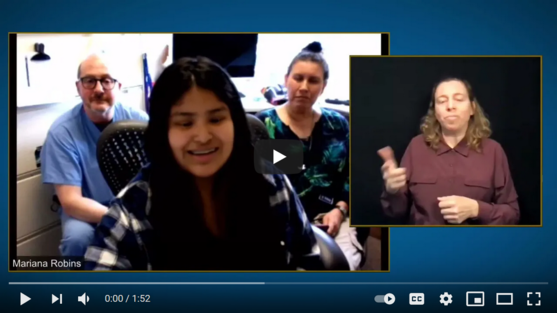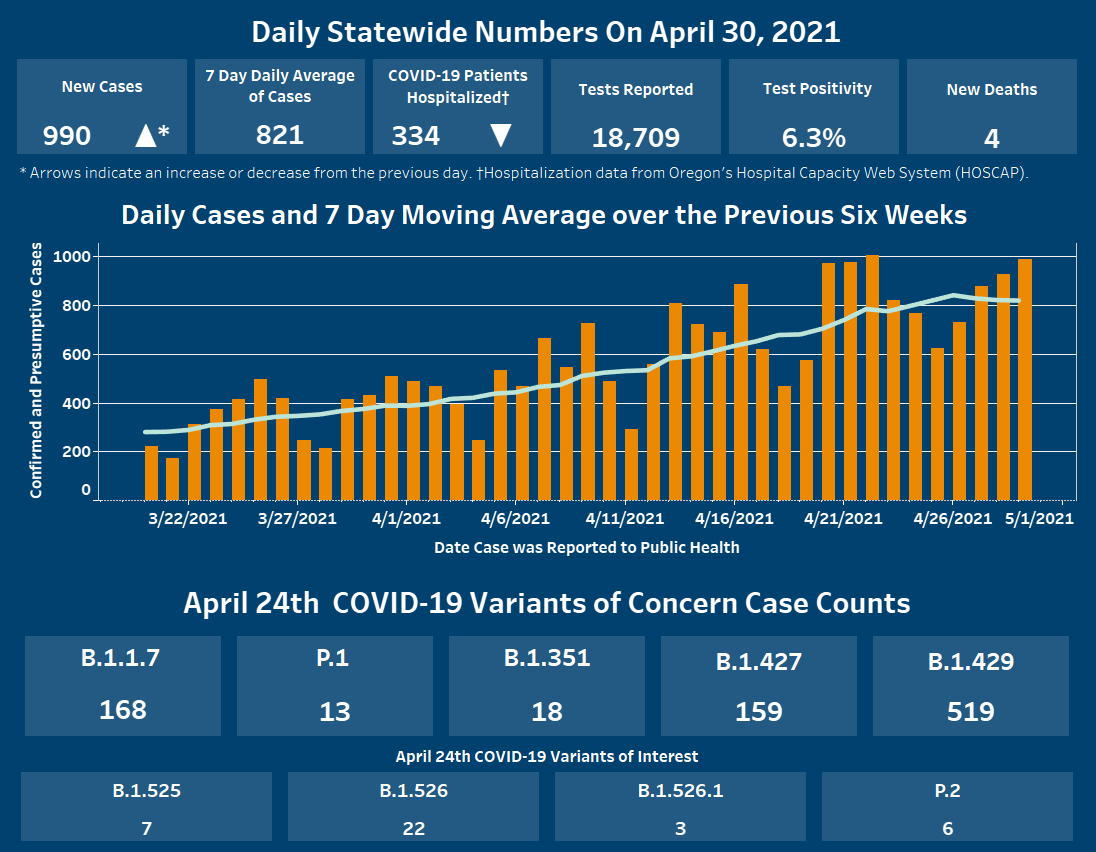 |
April 30, 2021
Teenager with long haul COVID-19 symptoms ‘strongly urges others to get the vaccine’
Mariana Robins, a 15-year-old high school sophomore, who became ill with COVID-19 in September of 2020 shared her experience with the illness. Mariana has long-haul symptoms that include memory loss, dizziness, migraines, severe pain and passing out without warning.
Mariana said, “Even though I’m slowly getting better and getting back to a normal high school life, post-COVID is still affecting me. It has made it harder to learn and remember things that I used to know pre-COVID. Before COVID I used to read all the time. Now I can’t even read a simple paragraph without getting tired and frustrated. With the help of my teachers and staff, they have been very supportive at my school.
After all this time suffering, I strongly urge others to get the vaccine because it can save your life and it can make sure that you and others don’t have to get affected the same way and have to suffer like I have. For me as a teenager, I strongly urge other teenagers to get the vaccine as well because this can happen to you.”
Click on the image below to see a video of Mariana telling her story at today’s news conference.
New modeling shows with precautions in place, we can save many lives
On April 30, Governor Kate Brown gave an update on the status of COVID-19 in Oregon. The Governor was joined by Dr. Peter Graven, Lead Data Scientist, Oregon Health & Science University and Mariana Robins, a 15-year old with long-haul COVID-19 symptoms.
The news conference addressed the recent increase in cases and hospitalizations:
- Cases have increased 20% or more for the last five weeks.
- Oregon is the state with the highest rate of increase in cases over the last two weeks.
- Hospitalizations are increasing at almost double what they were a week ago.
- The portion of hospitalized cases of people who are 18 to 34 has increased by almost 50 percent.
Dr. Peter Graven gave an overview of modeling predictions for the virus. He said the modeling shows that “we have just three to four more weeks until we’re in good shape. That’s when cases will fall, and our vaccine levels will be high enough that with basic preventive measures the virus cannot effectively grow.”
Acknowledging the sacrifice that comes with Extreme or High Risk levels, Dr. Graven pointed out that this pause is likely to save 176 lives and 700 hospitalizations.
To learn more about today’s news conference, you can find the news release here.
OHA experts answer your post-vaccination questions
On Wednesday, April 28, our experts answered post-vaccination questions. You can watch the video here. Below are the timestamps for the questions:
- 10:13 – How effective are the vaccines against the variants?
- 11:01 – What do I do if I lose my vaccination card?
- 11:38 – Will county-based restrictions be the same for vaccinated and unvaccinated individuals? For example, will there be adjustments to the group–size rules if all members of a group gathering are fully vaccinated?
- 13:19 – If I had a chain store pharmacy administer both COVID-19 vaccines without entering them into MyChart, does the pharmacy notify the Oregon Immunization Information System so that my immunization record is updated, or do I need to go through my primary care physician?
- 14:15 – Can you change guidelines to allow for fully vaccinated people to immediately be able to watch their children play sports or activities?
- 16:01 – If most of my employees or colleagues get vaccinated, can we drop the masks in the workplace?
- 16:55 – How many have died from the COVID-19 vaccines and are people getting COVID-19 from the vaccine?
- 20:20 – What about COVID-19 vaccine breakthrough cases? You talked earlier about people getting COVID-19 from the vaccine.
- 22:08 – Are we allowed to ask for COVID-19 vaccination cards if someone in the workplace is saying they aren’t required to quarantine after a COVID-19 exposure?
- 23:01 – Can you explain the similarities of the flu vaccines and the COVID-19 vaccines?
- 24:47 – If vaccines work, why do we still have to wear a mask?
- 26:05 – How long will it take us to reach herd immunity?
- 27:15 – If I got my second COVID-19 vaccine and find out four days later that I have been exposed to someone who tested positive for COVID-19, do I still have to quarantine?
- 28:07 – Why does it seem like that the more people who get vaccinated, the more cases we have?
- 29:29 – If we require COVID-19 vaccines in the workplace, are we allowed to ask for vaccination cards to show proof of protection, or is this protected?
Oregon reports 990 new confirmed and presumptive COVID-19 cases, 4 new deaths
There are four new COVID-19 related deaths in Oregon, raising the state’s death toll to 2,495, the Oregon Health Authority reported at 12:01 a.m. today.
Oregon Health Authority reported 990 new confirmed and presumptive cases of COVID-19 as of 12:01 a.m. today, bringing the state total to 184,812.
Vaccinations in Oregon
Today, OHA reported that 49,029 new doses of COVID-19 vaccinations were added to the state immunization registry. Of this total, 34,063 doses were administered on April 29 and 14,966 were administered on previous days but were entered into the vaccine registry on April 29. Cumulative daily totals can take several days to finalize.
The seven-day running average is now 35,329 doses per day.
Oregon has now administered a total of 1,594,712 first and second doses of Pfizer, 1,292,815 first and second doses of Moderna and 94,533 single doses of Johnson & Johnson COVID-19 vaccines. As of today, 1,253,053 people have completed a COVID-19 vaccine series. There are 1,819,329 who have had at least one dose.
To date, 1,892,475 doses of Pfizer, 1,583,600 doses of Moderna and 228,700 doses of Johnson & Johnson COVID-19 vaccines have been delivered to sites across Oregon.
These data are preliminary and subject to change.
OHA’s dashboards provide regularly updated vaccination data, and Oregon’s dashboard has been updated today.
Cases and deaths
The new confirmed and presumptive COVID-19 cases reported today are in the following counties: Baker (2), Benton (22), Clackamas (99), Clatsop (3), Columbia (5), Coos (6), Crook (11), Curry (2), Deschutes (81), Douglas (7), Grant (12), Harney (1), Hood River (1), Jackson (56), Jefferson (12), Josephine (16), Klamath (78), Lake (2), Lane (88), Lincoln (8), Linn (51), Malheur (2), Marion (93), Morrow (1), Multnomah (178), Polk (13), Tillamook (6), Umatilla (9), Wallowa (4), Wasco (8), Washington (101) and Yamhill (12).
Oregon’s 2,492nd death is a 97-year-old woman from Clackamas County who died on April 12, 2020 at her residence. The death certificate listed COVID-19 disease or SARS-CoV-2 as a cause of death or a significant condition contributing to death. She had underlying conditions.
Oregon’s 2,493rd death is a 49-year-old man from Josephine County who tested positive on April 10 and died on April 29 at Asante Three Rivers Medical Center. He had no underlying conditions.
Oregon’s 2,494th death is an 81-year-old man from Malheur County who tested positive on April 24 and died on April 28 at St. Alphonsus Regional Medical Center, in Boise, ID. Presence of underlying conditions is being confirmed.
Oregon’s 2,495th death is a 78-year-old woman from Crook County who tested positive on April 20 and died on April 26 her residence. She had underlying conditions.
COVID-19 hospitalizations
The number of hospitalized patients with COVID-19 across Oregon is 334, which is five fewer than yesterday. There are 73 COVID-19 patients in intensive care unit (ICU) beds, which is two more than yesterday.
The total number of COVID-19 positive patient bed-days in the most recent seven days is 2,232, which is a 28.0% increase from the previous seven days. The peak daily number of beds occupied by COVID-19 positive patients in the most recent seven days is 339.
The total number of patients in hospital beds may fluctuate between report times. The numbers do not reflect admissions per day, nor the length of hospital stay. Staffing limitations are not captured in this data and may further limit bed capacity.




